Phaeolus schweinitzii
Scientific name: Phaeolus schweinitzii (Fr.) Pat.
Derivation of name: Phaeolus means "dark" or "obscure";
schweinitzii means it was named for L.D. von Schweinitz,
American mycologist (1780-1834).
Synonymy: Polyporus schweinitzii Fr.
Common names: Dye polypore.
Phylum: Basidiomycota
Order: Polyporales
Family: Polyporaceae
Occurrence on wood substrate: Parasitic and saprobic;
solitary or in overlapping clusters or rosettes on buried roots
and at the base of living conifers, sometimes on dead stumps;
rarely reported on deciduous trees; June through November.
Dimensions: Individual caps 4-25 cm wide; clusters up to 60
cm (or more); stalks (when present) 1-6 cm long and 1-4 cm
thick, branched or unbranched, central or eccentric,
sometimes
rooting.
Upper surface: Densely matted or wooly, less so with age;
ochre to orange or reddish-brown with yellow margin when
young, rusty-brown to dark brown in age; somewhat zonate.
Pore surface: Greenish-yellow to yellow or orange when
young, bruising brownish, yellowish-brown to dark reddish or
rusty-brown in age; pores 0.5-3 per mm.
Comments: The Dye polypore is used to prepare dyes for
fabrics (Figure 11). This polypore encompasses twigs,
needles,
and grass as it develops. Check with field guides to
compare with similar Inonotus tomentosus which is smaller
and thinner, does not have the greenish-yellow pore
surface,
and does not grow in overlapping rosettes.
Phaeolus
schweinitzii is a significant parasite, often killing
the host tree
as a result of the root and butt rot it causes.
More information at TomVolkFungi.net:
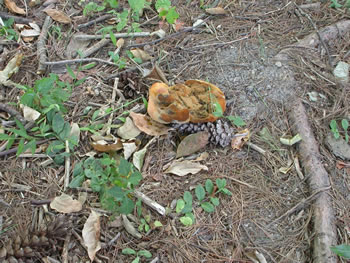
Figure 1. Phaeolus schweinitzii on the ground associated
with the roots of eastern white pine (Pinus strobus).
Photo © Gary Emberger.

Figure 2. Typical overlapping cluster of Phaeolus
schweinitzii on the ground. Photo © Larry Grand.
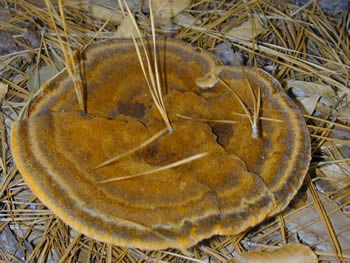
Figure 3. A single, circular cap of Phaeolus schweinitzii.
Photo © Tom Volk.
Figure 4. Note the yellow margins of these young
specimens. Photo © George
Barron.

Figure 5. A beautiful specimen of Phaeolus schweinitzii
collected at the 2008 NEMF foray in Connecticut. This
cluster is about 30 cm in diameter. Photo © Gary Emberger.
Figure 6. Unlike some polypore species, this polypore
species surrounds and
encompasses vegetation and other
objects it
contacts as it grows. Several species were
"swallowed up"
by the specimen above including a young
poison ivy plant.
Photo © Gary Emberger.
Figure 7. This specimen is encompassing a fallen cluster
of pine needles. The five-needled cluster identifies the tree
as white pine (Pinus strobus) a common host of the
parasitic Phaeolus schweinitzii.
Photo © Gary Emberger.

Figure 8. The pore surface of younger specimens is
typically some shade of greenish-yellow. Photo © Gary
Emberger.
Figure 9. A closer view of the pores of the specimen in
figure 8. Photo © Gary Emberger.
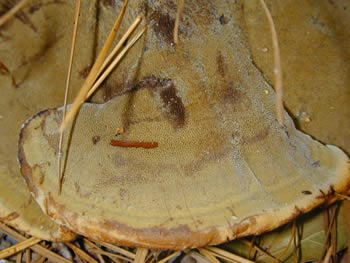
Figure 10.
Note the bruising on the brownish pore surface
of
this older specimen.
Photo © Tom Volk.
Figure 11. Various colors of wool dyed with pigments from
Phaeolus schweinitzii and using different mordants.
The wool color
sample was provided by Gail Blakely.
Photo © Gary Emberger.